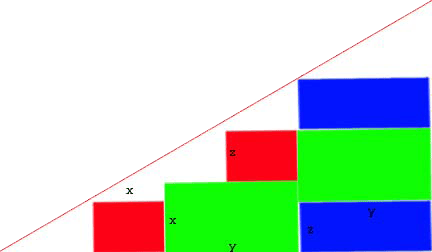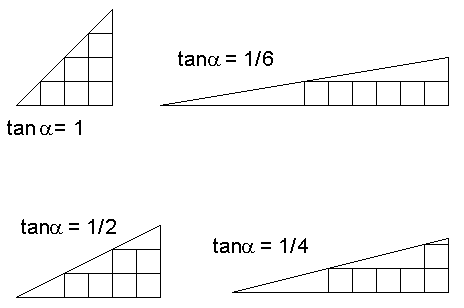 Author
Author |
Topic: Cutting A Box From Triangular Stock (Read 4335 times) |
|
william wu
wu::riddles Administrator
    


Gender: 
Posts: 1291
|
You are given a right-triangular sheet of metal with base b and height h. You want to cut six rectangles from this metal such that the rectangles can be assembled to form a rectangular prism (box), and the volume of this prism is maximized.
Restrictions: When sawing the triangle, you are able to guide the cutting blade in directions antiparallel to the triangle's sides, and start the cutting blade wherever you want. However, you can only make one continuous slice through the triangle. That is, you can only cookie-cut one connected shape out of the triangle, and no more. That shape is then dissected into 6 rectangles according to a pattern you design, and there should be no leftover metal. In other words the rectangles should be closely packed.
See the appended image for an example legal cut. The area shaded white is wasted metal.
Note: I got this online from some random 17 year-old who said this was a design problem in his engineering class. I don't know if there's a closed-form answer for this ... if not, we could still have an interesting discussion, bouncing ideas on ways to approximate an optimal cut. But then maybe it should be in the CS section?
[edit] 9:07 AM 9/9/2003: Noted that you're given a *right* triangle.
|
| « Last Edit: Sep 9th, 2003, 9:08am by william wu » |
 IP Logged IP Logged |

[ wu ] : http://wuriddles.com / http://forums.wuriddles.com
|
|
|
James Fingas
Uberpuzzler
    


Gender: 
Posts: 949
|
I have been thinking about this problem, and it seems to me that a good conceptual starting point is the solution for [alpha] = 45 degrees, which is probably six squares in rows of 3,2,1. We can, WLOG, confine our consideration to [alpha] <= 45 degrees.
I was thinking that we could start off by stretching the solution in one direction for small changes in [alpha], but I think that's the wrong way to go about it, because the volume of the rectangular prism is maximized for a specific surface area by making it a cube.
Therefore, I think a good strategy will take the value of [alpha], and consider the best way to cut out a cube. Going from there, small changes in the lengths of the sides should give an optimal solution. There are only four possible arrangements for a cube (shown below). From here, we could look at each fundamental arrangment of the pieces and find a few different ways of maximizing them for slightly different [alpha].
This solution intentionally ignores more radical arrangements of pieces, and I think that's justified, because generally such arrangements are made with pieces that are significantly non-square.
|
|
 IP Logged IP Logged |

Doc, I'm addicted to advice! What should I do?
|
|
|
SWF
Uberpuzzler
    

Posts: 879
|
 |
Re: Cutting A Box From Triangular Stock
« Reply #2 on: Sep 26th, 2003, 6:50pm » |
 Quote Quote  Modify Modify
|
on Sep 22nd, 2003, 1:36pm, James Fingas wrote:| This solution intentionally ignores more radical arrangements of pieces, and I think that's justified, because generally such arrangements are made with pieces that are significantly non-square. |
|
For the case of an isosoles right triangle, your method of filling it with 6 squares to make a cube is not the optimum, nor are any of the other patterns. Assuming a leg of the triangle has length 1, the 6 squares would be of side length of 0.25, and form a box of volume 0.25*0.25*0.25 = 0.015625 = 1/64. There is a fairly simple way to get a volume of more than that:
Two squares and 4 dominoes (same size as a pair of squares) fit inside the triangle with same outline as how ten 0.2 by 0.2 squares fit. Volume of the block formed from them is 0.2*0.2*0.4=0.16 = 2/125.
|
|
 IP Logged IP Logged |
|
|
|
|
 WRITE MATH!
WRITE MATH!
 Home
Home  Help
Help  Search
Search  Members
Members  Login
Login  Register
Register WRITE MATH!
WRITE MATH!
 Home
Home  Help
Help  Search
Search  Members
Members  Login
Login  Register
Register